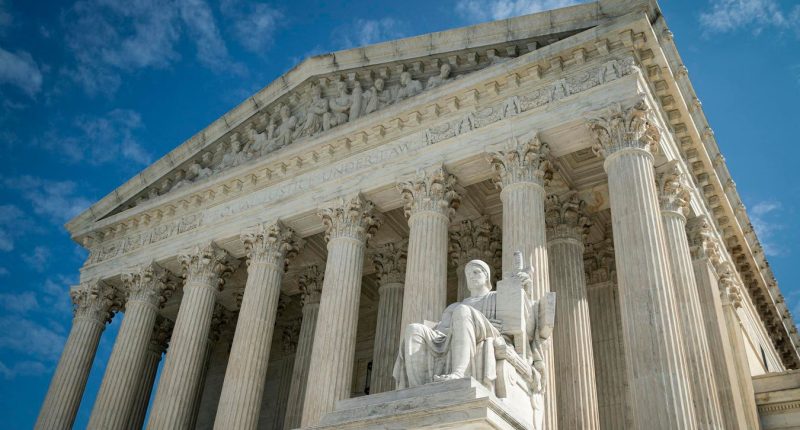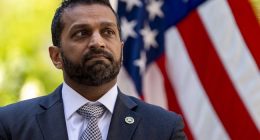Share this @internewscast.com
Topline
The Supreme Court said Monday that a case over a Biden-era student loan forgiveness rule will resume—after the Trump administration briefly put the litigation on hold—which could affect thousands of borrowers who want to have their loans discharged after their schools closed or defrauded them.
The Guardian or Authority of Law, created by sculptor James Earle Fraser, rests on the side of the … More
Getty Images
Key Facts
The Supreme Court agreed Monday to resume Department of Education v. Career Colleges and Schools of Texas, a dispute over a 2022 rule that streamlines the process for borrowers to have their federal loans discharged if their schools closed or engaged in misconduct.
While borrowers have always been able to try to get out of defaulting on their loans by alleging misconduct by their school, the 2022 rule—created after a huge influx of complaints led to a significant backlog—defined clear grounds for borrowers to be able to have their loans discharged before they default on them, making the process of challenging them much easier.
Under the rule, known as “Borrower Defense Loan Discharge,” borrowers can challenge their loans if their school commits misconduct through misrepresentation, substantial omission of fact, breach of contract or aggressive or deceptive recruitment, if if there’s a court ruling that the school violated the law, or the Department of Education takes away the school’s ability to participate in federal student loan programs based on any misconduct.
The rule also allows loans to be discharged if a borrower’s school closed while they were enrolled or if they withdrew from the school less than 180 days before it closed, and makes it easier for groups to collectively seek relief from student loans, such as on behalf of borrowers who attended a specific school during the same years.
A federal appeals court struck down the 2022 rule and made it even harder for borrowers to get out of paying their loans due to misconduct, saying they could only present those defenses in court after already defaulting on their loans.
The Biden administration asked the Supreme Court to overturn the appeals court’s ruling and the court agreed in January to take up the case for oral arguments, but the Trump administration then put the case on pause for a few months while it considered whether it agreed with the Biden administration’s argument—ultimately saying in May it does agree and the court should resume the case.
What To Watch For
The Supreme Court still hasn’t scheduled the case for oral arguments yet, though it’s expected to be heard at some point during the court’s next term, which runs from October through June 2026. A decision in the case would be announced by the end of June 2026.
Can Borrowers Challenge Their Loans Now While The Case Is Pending?
The Education Department is not adjudicating any requests while the litigation is pending for borrowers to have their loans discharged for either misconduct or a school closing. Borrowers can still submit an application for relief under the rule in the meantime, but must continue paying their loans until the program resumes—if it does—and they’re notified the application was successful and their loans are discharged. If their loans are discharged, then borrowers may be able to have the loan payments they previously made refunded, per the Department of Education’s guidance, in addition to no longer having to make loan payments going forward. Borrowers should consult their loan servicer to determine their specific eligibility for a refund.
What Happens If The 2022 Student Loan Forgiveness Rule Is Struck Down?
If the Supreme Court rules against the government and upholds the appeals court ruling, that would mean borrowers whose schools committed misconduct or closed would likely only be able to use that as a defense if they default on their loans, rather than being able to use it preemptively as a way to have their loans forgiven. The Biden administration warned that would lead to a huge backlog of complaints and strain the government’s resources, should thousands of borrowers now have to present their cases in court, and would harm borrowers by forcing them to default on their loans in order to possibly get relief. “Taxpayer resources would be spent resolving hundreds of thousands of collection suits in which there is no real controversy because both the lender and the borrower agree that the borrower has a valid defense to repayment,” the Biden administration argued, also claiming “vulnerable borrowers who are subject to fraudulent schemes would be saddled with debt that they cannot discharge without first risking wage garnishment, credit-report damage, and offsets against federal benefits.” The Trump administration told the Supreme Court it will aim to create a replacement rule that would be similar in trying to streamline the process for seeking loan forgiveness, should the high court strike the 2022 rule down.
Key Background
The 2022 rule making it easier for borrowers to challenge their loans was part of a broader slew of measures on student loan forgiveness that came out during the Biden administration. The Biden administration broadly sought to relieve student debt, but faced challenges in its efforts to provide more universal loan relief, with the Supreme Court ultimately striking down the government’s program to provide sweeping forgiveness to tens of millions of federal borrowers. The administration instead implemented a series of more targeted measures aimed at specific groups of borrowers, saying in January it had approved $188.8 billion in student loan forgiveness. The Trump administration’s decision to continue the lawsuit over the Borrower Defense Loan Discharge program comes as top officials have otherwise been largely opposed to student loan forgiveness, with Education Secretary Linda McMahon saying in April that “American taxpayers will no longer be forced to serve as collateral for irresponsible student loan policies.” The White House has made several changes to the federal student loan program, most notably by trying to move it to the Small Business Administration and by resuming collections on defaulted loans. President Donald Trump’s signature policy bill would also broadly overhaul student loans and student loan repayment plans, including by abolishing current income-driven repayment plans and imposing caps on new student loans. That legislation passed the House but is still pending in Congress, with the Senate expected to begin voting on it this week.
Further Reading











